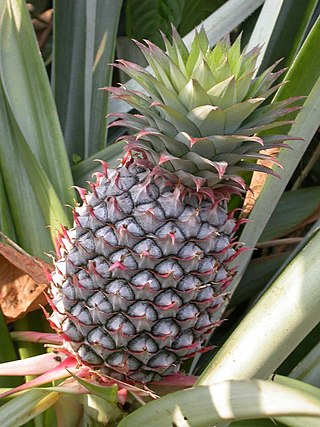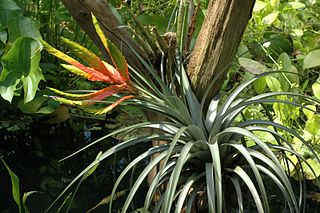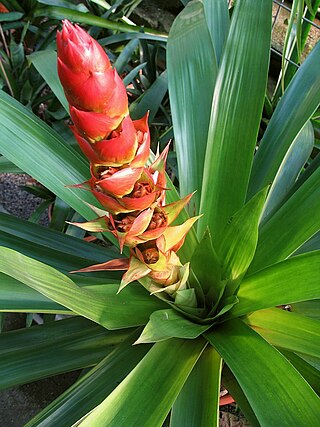
The Bromeliaceae are a family of monocot flowering plants of about 80 genera and 3700 known species, native mainly to the tropical Americas, with several species found in the American subtropics and one in tropical west Africa, Pitcairnia feliciana.

Wittmackia is a genus of flowering plants in the family Bromeliaceae.

Bromelioideae is a subfamily of the bromeliads (Bromeliaceae). This subfamily is the most diverse, represented by the greatest number of genera with about 40. Most of the plants in this group are epiphytes, though some have evolved in, or will adapt to, terrestrial conditions. This subfamily features the most plant types which are commonly cultivated by people, including the pineapple.

Pitcairnioideae is a subfamily of the bromeliad family, Bromeliaceae. Traditionally, it was a large subfamily, comprising all those species with winged or more rarely naked seeds. Molecular phylogenetic studies showed that traditional Pitcairnioideae was not monophyletic, and the subfamily was more narrowly circumscribed. As of November 2022, the Encyclopaedia of Bromeliads placed five genera in the subfamily. Members of the subfamily are found from the Andes to the coast of Brazil, with one genus (Fosterella) found northwards to Mexico.

Tillandsioideae is a subfamily of plants in the bromeliad family Bromeliaceae. This subfamily contains the greatest number of species. Most are epiphytic or lithophytic, growing in trees or on rocks where they absorb water and nutrients from the air. Spanish moss of the genus Tillandsia is a well-known species. Bromeliads in the genera Guzmania and Vriesea are the more commonly cultivated members of this subfamily.

Glomeropitcarnia is a genus of the botanical family Bromeliaceae, subfamily Tillandsioideae. The genus name is from the Latin “glomero” and the genus Pitcairnia. It has two known species, native to Venezuela, Trinidad and the Lesser Antilles.

Mezobromelia is a genus of the botanical family Bromeliaceae, subfamily Tillandsioideae. The genus name is for Carl Christian Mez, German botanist (1866-1944). Some authorities treat Mezobromelia as a synonym of Cipuropsis.

Wallisia pretiosa is a species of plant in the family Bromeliaceae. It is endemic to Ecuador. Its natural habitats are subtropical or tropical moist lowland forests and subtropical or tropical moist montane forests.
Julian Alfred Steyermark was a Venezuelan American botanist. His focus was on New World vegetation, and he specialized in the family Rubiaceae.
Arthur Francis George Kerr (1877–1942) was an Irish medical doctor. He is known particularly now for his botanical work, which was important for the study of the flora of Thailand.

Wallisia anceps is a species of flowering plant in the genus Wallisia. This species is native to Central America, Colombia, Ecuador, Trinidad and Tobago, the Guianas, Venezuela and northern Brazil.

Zizkaea is a monotypic genus of flowering plants belonging to the family Bromeliaceae. It only contains one known species, Zizkaea tuerckheimii.
Waltillia is a genus of flowering plants belonging to the family Bromeliaceae. It was considered to be a monotypic genus until the 2021 description of W. itambana.
Jagrantia is a monotypic genus of flowering plants belonging to the family Bromeliaceae. It only contains one species, Jagrantia monstrum.

Goudaea is a genus of flowering plants belonging to the family Bromeliaceae.
Gregbrownia is a genus of flowering plants belonging to the family Bromeliaceae.

Lemeltonia is a genus of flowering plants belonging to the family Bromeliaceae.














